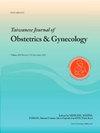台湾分娩和产后住院产妇严重发病率的趋势和相关因素:2011-2021 年全国性研究
IF 2
4区 医学
Q2 OBSTETRICS & GYNECOLOGY
引用次数: 0
摘要
目的 调查台湾全国范围内严重孕产妇发病率(SMM)的患病率和纵向趋势,并分析导致严重孕产妇发病率的相关孕产妇因素。材料与方法利用台湾卫生福利部发布的 2011 年至 2021 年行政数据集进行了基于人口的二次分析。SMM 的定义来自疾控中心之前发布的 ICD-9 或 10-CM 诊断和手术代码。在胎龄≧20周和产后42天内,通过分娩和产后住院确定的任何SMM指标都会被检索出来进行分析。趋势检验采用 Kendall Tau-b 相关性。采用逻辑回归法研究SMM的相关孕产因素。所有数据均使用 SAS 统计软件 9.4 版进行分析。统计显著性定义为 P 值 < 0.05。有 6961 例符合 SMM 指标,平均每 1000 例分娩中有 3.4 例符合 SMM 指标。纯输血率为 2.33%。包括输血在内的总体 SMM 比率达到每千次分娩 26.7 例。包括输血和不包括输血的 SMM 呈明显上升趋势。高龄产妇和剖宫产是 SMM 的两个主要相关因素。输血率的急剧上升使得预防产科出血成为当务之急。卫生政策的重点应放在鼓励早育和避免不必要的剖腹产上,以降低 SMM 带来的产妇风险。需要对 SMM 进行持续监测,以改善产科护理,减少严重的孕产妇并发症。本文章由计算机程序翻译,如有差异,请以英文原文为准。
The trend and factors associated with severe maternal morbidity among delivery and postpartum hospitalizations in Taiwan: A nationwide study, 2011–2021
Objective
To investigate the prevalence and longitudinal trend of severe maternal morbidity (SMM) at nationwide level in Taiwan. The associated maternal factors contributing to SMM were also analyzed.
Materials and methods
A population-based secondary analysis using administrative datasets released by Ministry of Health and Welfare of Taiwan from 2011 to 2021 was carried out. SMM was defined from ICD-9 or10-CM diagnosis and procedure codes previously released by CDC. The existence of any SMM indicators identified by delivery and postpartum hospitalizations between≧20 weeks of gestational age and within 42 days after childbirth was retrieved for analysis. Kendall Tau-b correlation was applied for trend test. Logistic regression was used to investigate the associated maternal factors for SMM. All the data were analyzed using SAS statistical software version 9.4. Statistical significance was defined as P value < 0.05.
Results
A total of 2,054,010 delivery hospitalization records were identified during the study period. 6961 subjects met the SMM indicators, yielding an average SMM rate of 3.4 per 1000 deliveries. The pure transfusion rate was 2.33%. The overall SMM rate including transfusion reached 26.7 per thousand deliveries. The trend of SMM including and excluding transfusion demonstrated significantly increasing. Extreme maternal age and cesarean delivery were two main maternal associated factors for SMM.
Conclusion
Our findings demonstrated the steadily increasing trend of SMM in the past decade from nationwide study in Taiwan. The sharply growing rates of blood transfusion made the prevention of obstetric hemorrhage imperative. Health policies should be focused on the encourage of early childbearing and avoidance of unnecessary cesarean delivery to reduce the maternal risks associated with SMM. Continuous surveillance of SMM is required to improve obstetric care and reduce severe maternal complications.
求助全文
通过发布文献求助,成功后即可免费获取论文全文。
去求助
来源期刊

Taiwanese Journal of Obstetrics & Gynecology
OBSTETRICS & GYNECOLOGY-
CiteScore
3.60
自引率
23.80%
发文量
207
审稿时长
4-8 weeks
期刊介绍:
Taiwanese Journal of Obstetrics and Gynecology is a peer-reviewed journal and open access publishing editorials, reviews, original articles, short communications, case reports, research letters, correspondence and letters to the editor in the field of obstetrics and gynecology.
The aims of the journal are to:
1.Publish cutting-edge, innovative and topical research that addresses screening, diagnosis, management and care in women''s health
2.Deliver evidence-based information
3.Promote the sharing of clinical experience
4.Address women-related health promotion
The journal provides comprehensive coverage of topics in obstetrics & gynecology and women''s health including maternal-fetal medicine, reproductive endocrinology/infertility, and gynecologic oncology. Taiwan Association of Obstetrics and Gynecology.
 求助内容:
求助内容: 应助结果提醒方式:
应助结果提醒方式:


